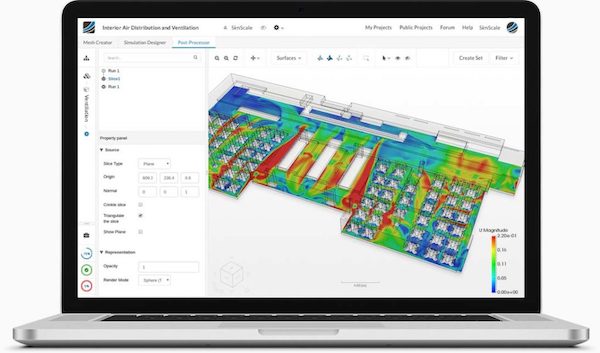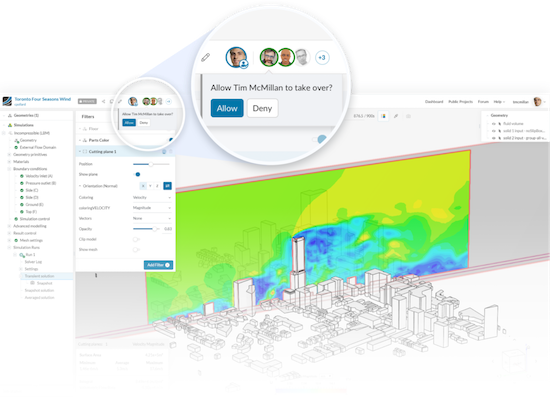
Figure 1: Cloud-based CAE software runs in a standard web browser. Image courtesy of SimScale.
Latest News
May 28, 2021
Guest commentary by Arnaud Girin, Technical Marketing Specialist, SimScale
Computer-aided engineering (CAE) or engineering simulation defines the entire product engineering process, from design creation and virtual testing with sophisticated analytical algorithms to the planning of manufacturing. CAE technology is standard in almost any industry that uses design software. Supporting the engineering process, it enables a complex testing process through numerical simulation of a product’s physical properties in different conditions and environments without building a prototype. The field of CAE includes computational fluid dynamics, finite element analysis, thermal analysis, multibody dynamics, and optimizations.
By using engineering simulation, especially when combined with the power and speed of high-performance cloud computing, the cost and time of each design iteration cycle and the overall development process are significantly reduced.
The standard CAE workflow begins with generating an initial design, meshing it, adding boundary conditions, and setting up the analysis parameters to then run it. The simulation results obtained are then evaluated and used to improve the design.
In an iterative design process, these steps are repeated until all requirements are met and confirmed with simulation results. This process supports faster product development as there is no need for building physical prototypes in early development stages.
Challenges in CAE Software Adoption
As a complement to wind tunnel testing, which is paramount in the later design stages, engineering simulation can be used to identify design problems or optimization potential early on. CAE software is not a new technology; first developed for aerospace and automotive, it has been used for more than 50 years. Nowadays, almost all industries make use of FEA or CFD analysis, from construction, HVAC, and industrial equipment to electronics, consumer goods or healthcare. But while computer-aided design (CAD) software has already had decades of widespread adoption, being a standard technology in any engineer’s toolbox, CAE is still considered a privilege to companies or projects with high budgets.
While engineering simulation is a mature technology, still only a fraction of engineers are using it in product development. This is due to the barriers that accompany traditional simulation tools: HPC hardware overhead, high fixed costs for software licenses and hardware, and the high level of know-how required to make effective use of on-premises CAE tools.
Current Status of the CAE Industry
The global computer-aided engineering (CAE) market is set to grow with a CAGR of 10.3% to reach over $13 billion by 2026.
The industry’s focus on productivity and efficiency is driving the adoption of CAE, particularly for CFD and FEA. Engineering simulation offers more accuracy in the design testing stage, by reducing the number of required physical prototypes. CAE is only meant to be a complement to physical experiments, in an iterative design process, not its replacement. Giving early feedback on the performance of a design, the time to market can be significantly shortened.
Despite its benefits, the limitations in using traditional, desktop-based CAE solutions are real challenges in the adoption of this powerful technology. To these barriers, cloud computing brings a solution.
Cloud Computing: Emergence and Benefits
Cloud computing is the offering of computing resources as a service through the Internet. This can range from basic processing and storage services to higher-level managed applications. Users of cloud computing can avoid purchasing, setup, and maintenance of often complex systems, and make use of on-demand scalability and metering/billing.
Adopted by a wide range of industries, the cloud is a perfect fit for CAE, which is a very computationally-intensive technology. Here are its main benefits:
Availability: Solutions based on cloud computing can be accessed in a standard web browser, from a normal computer. As long as the user has Internet connection, they can access it anytime, anywhere.
Scalability: The cloud makes it possible to rent more or better computers, depending on the need at a particular time. This also applies to storage. With CAE software, when more complex simulations need to be run, the number of core hours can be increased.
Pricing: Cloud-based solutions are strongly connected with cost-effectiveness since they eliminate the need for investing in hardware. Moreover, they are usually delivered as SaaS (software as a service), which allows customers to pay on a subscription basis, either monthly or yearly, depending on the software type and the provider.
Cloud-based tools are already integrated into our lives and respective workflows. Conferencing systems, storage, CRM systems, payroll, accounting, and many more areas have moved to the cloud, increasing efficiency, improving accessibility, and saving time and money. In computer-aided engineering, besides these benefits, it has also removed the hassle of software installation and maintenance, which are now handled by the simulation software providers.
With the world pushing for digitalization, and even more in the past few months, the topic of being able to work remotely, accessing all tools from anywhere without being bound to a location has become top of mind for companies. In this context, collaboration possibilities have also emerged as a necessity to keep teams connected.

In the CAE field, cloud-based platforms like SimScale allow multiple users to work online simultaneously, on the same simulation project from any location, and on a standard computer—all in real-time. Once a simulation project is shared, all team members have access to the same version (similar to Google Docs) and all changes are tracked and available within a dashboard. This enables engineering teams to work on design projects in real-time even if they are not in the office, share simulation knowledge, and give feedback to colleagues quicker and more efficiently than ever before possible.
Through collaboration options such as these, an iterative design process is enabled through the cloud, saving time.
Conclusion
No matter if we talk about on-premises or cloud-based simulation software, the CAE industry is steadily growing. With an increasing need for automatization and efficiency, its benefits are undeniable in product design as well as across all facets of the construction industry. While both types of solutions boast strong advantages, we can summarize the following conclusions.
Traditional CAE tools have a wide range of features, developed over several decades, which makes them state-of-the-art, but they lack accessibility and collaboration options. Cloud-based solutions offer much more flexibility, ease of use, and facilitate cloud migration at the organization level as well as fit into the new digital workplace workflow. As they are new, dynamic, and malleable compared to their desk-chained counterparts, these solutions have the capacity to adapt and include whatever new features are needed and push them out to end users without any manual installation. Nevertheless, being newer on the market, cloud-based solutions are still products in development, sometimes lacking some of the more niche features needed in some industries. Every company, in the end, needs to evaluate their virtual testing needs. In the long run, however, like all industries, CAE will also need to step into the digital world.

With a mechanical design background, Arnaud Girin has worked for six years on industrial product performance optimization with CFD and FEA tools, of which three years in centrifugal pump design. Currently, he is employed by the cloud-based simulation provider SimScale and is involved in simulation projects for multiple industries.
More SimScale Coverage

Subscribe to our FREE magazine, FREE email newsletters or both!
Latest News







